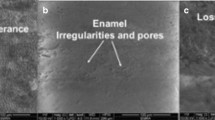Summary
Transmission electron microscopy of selected-area argon-ion-beam thinned kangaroo (Macropus giganteus) enamel revealed a complex ultrastructure in the region of the dentine-enamel junction (DEJ). Characteristic features were multiple branching of dentinal tubules, rejoining of enamel tubules, elongated defects, extended protrusions of dentine into enamel, two types (A and B) of hypomineralized enamel and a continuity between dentinal and enamel tubules. In the intertubular regions of the DEJ a complex intermingling of finer enamel and dentine crystals, similar to that found in human enamel, was observed. The varicosities observed in the light microscope were a combined optical effect caused by the hypomineralized (type A) enamel and the branching and rejoining of the enamel tubules.
Similar content being viewed by others
References
Boyde A, Lester KS (1967). The structure and development of marsupial enamel tubules. Z Zellforsch 82:558–576
Chalmers B (1964) Principles of solidification, Wiley, N.Y.
Fosse G (1969) The tubules of marsupial enamel investigated by normal light, by polarized light and by contact microradiography. Acta Odont Scand 27:237–248
Fosse G, Holmbakken N (1971) Fibrils in marsupial enamel tubules. Z Zellforsch 115:341–350
Fosse G, Risnes S, Holmbakken N (1973) Prisms and tubules in multituberculate enamel. Calcif Tiss Res 11:133–150
Lester KS (1970) On the nature of “fibrils” and tubules in developing enamel of the Opossum, Didelphis marsupialis. J Ultrastruct Res 30:64–77
Moss ML, Applebaum E (1963). The fibrillar matrix of marsupial enamel. Acta Anat 53:289–297
Orams HJ, Phakey PP, Rachinger WA, Zybert JJ (1974). Visualization of micropore structure in human dental enamel. Nature 252:584–585
Orams HJ, Zybert JJ, Phakey PP, Rachinger WA (1976) Ultrastructural study of human dental enamel using selected area argon-ion-beam thinning. Arch Oral Biol 21:663–675
Orams HJ, Phakey PP, Rachinger WA, Zybert JJ (1980) Ultrastructural changes in the translucent and dark zones of early enamel caries. J Oral Pathol 9:54–61
Osborn JW (1974) The relationship between prisms and tubules in the teeth of Didelphis marsupialis, and the probable origin of the tubules. Arch Oral Biol 19:835–844
Palamara J, Phakey PP, Rachinger WA, Orams HJ (1980) Electron microscopy of surface enamel of human unerupted and erupted teeth. Arch Oral Biol 25:715–725
Palamara J, Phakey PP, Rachinger WA, Orams HJ (1981) The ultrastructure of kangaroo enamel (Macropus giganteus): Tubular enamel and its “black spot” defects. Aust J Zoology (in press)
Phakey PP, Rachinger WA, Orams HJ, Carmichael GC (1974) Preparation of thin sections of selected areas. In: Sanders JV, Goodchild PJ (eds) Electron microscopy Vol1. Australian Academy of Science, Canberra, pp 412–413
Poole DFG (1967) Phytogeny of tooth tissues: anameloid and enamel in recent vertebrates, with a note on the history of cementum. In: Miles AEW (ed) Structural and chemical organization of teeth. Vol 1. Academic Press, N.Y. and London, pp 111–149
Powder Diffraction File for Inorganic Materials (1979). (Managing editor McClune, WF) JCPDS International Centre for Diffraction Data, Park Lane; Swathmore, Pennsylvania, USA
Risnes S, Fosse G (1974) The origin of marsupial enamel tubules. Acta Anat 87:275–282
Whittaker DK (1978) The enamel-dentine junction of human and Macaca irus teeth: a light and electron microscopy study. J Anat 125:323–335
Author information
Authors and Affiliations
Rights and permissions
About this article
Cite this article
Palamara, J., Phakey, P.P., Rachinger, W.A. et al. Electron-microscope study of the dentine-enamel junction of kangaroo (Macropus giganteus) teeth using selected-area argon-ion-beam thinning. Cell Tissue Res. 221, 405–419 (1981). https://doi.org/10.1007/BF00216744
Accepted:
Issue Date:
DOI: https://doi.org/10.1007/BF00216744




